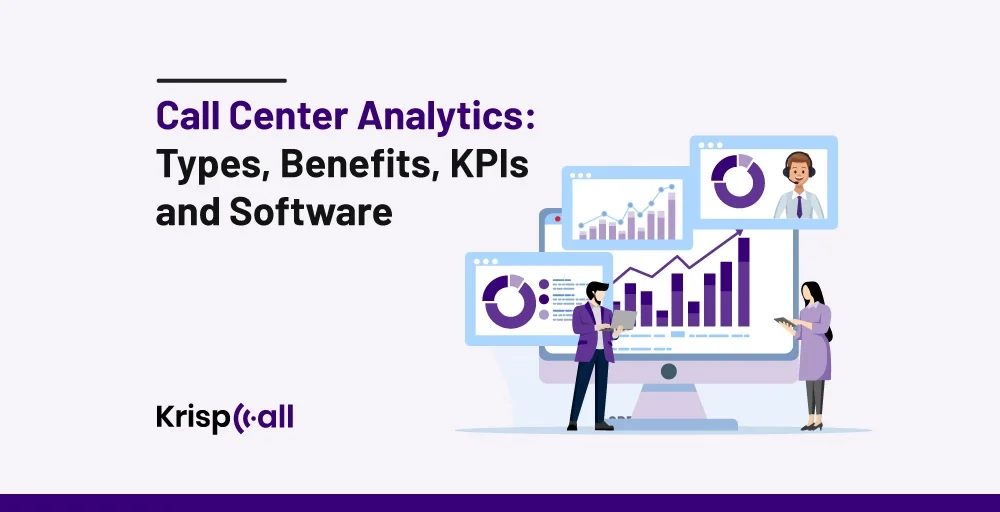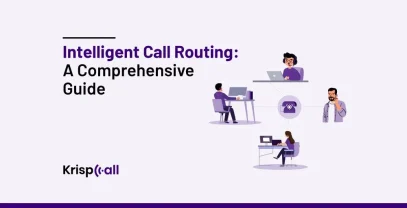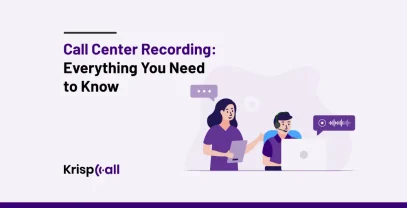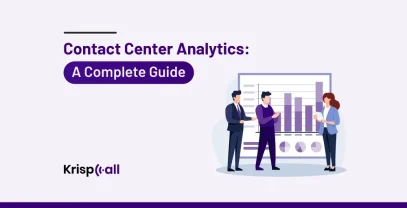Businesses that fail to analyze call center data are missing a golden opportunity. When you are unable to identify customer pain points or areas for improvement, it can lead to a frustrating 😡 experience for both customers and agents with long wait times and unresolved issues.
This is where call center analytics enters as a powerful tool, providing insight into agents and overall call center performance. You can harness the wealth of data generated through customer interactions to craft a superior customer service experience.
This guide will help you understand call center analytics, its types, benefits, and drawbacks. We will also discuss call center analytics use cases, key metrics to track, and the top 3 call center analytics software to choose for your business.
🔑 KEY HIGHLIGHTS
- Call center analytics involves gathering, assessing, and analyzing key performance indicators (KPIs) and metrics.
- Business intelligence, interaction analytics, speech analytics, predictive analytics, and self-service analytics are five different types of call center analytics.
- Call center analytics helps boost agent performance, improve customer satisfaction, and allow data-driven decisions to be made.
- If you’re aiming to enhance your call center operations, KrispCall stands out as a top provider of call analytics software.
What is Call Center Analytics?
Call center analytics is a process of collecting, measuring, and analyzing the key performance indicators (KPIs) and metrics. These KPIs typically include average handle time, call volume, average hold time, customer satisfaction (CSAT) score, and many more.
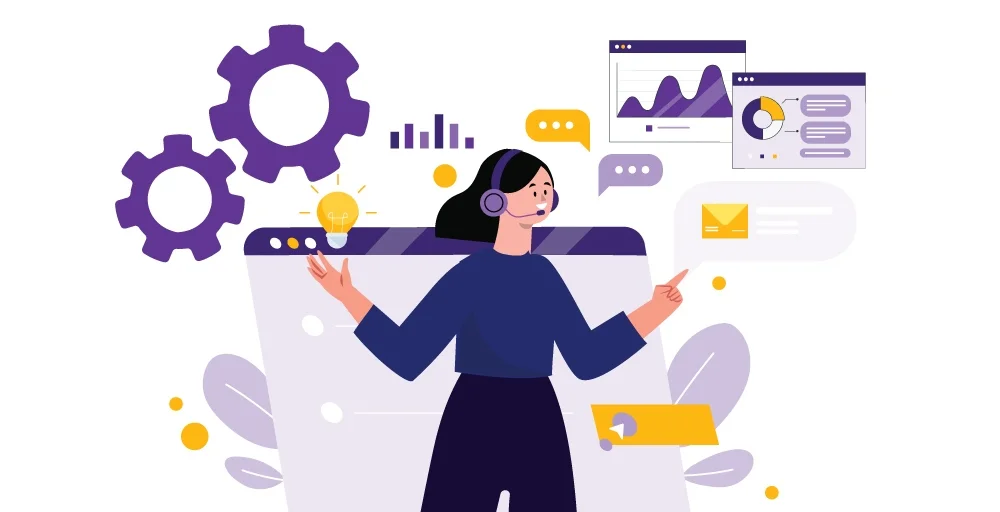
Utilizing call center analytics alongside a comprehensive call center wallboard can provide real-time insights into agent performance and call metrics and enable supervisors to make data-driven decisions for optimizing operations.
You can gain insight into agent performance, customer satisfaction, and call center performance with call center analytics. The main aim of call center analytics is to offer you actionable insights that lead to better decision-making. It helps you to transform your contact center operation from reactive to proactive.
Types of Call Center Analytics
There are different types of call center analytics that you can use for your business. Using these tools, you can gain a 360-degree view of customer history and a holistic understanding of contact center performance.
Here are five major types of call center analytics:
1. Business Intelligence
Business intelligence helps managers or supervisors gain an overview of your agent and call center performance. This tool provides you with valuable data that allows you to pinpoint the areas for improvement in your call center. In addition, you can also identify agents that are highly productive or those who need training.
Utilizing this information, you can tailor specific training sessions for your agents based on their individual needs and performance metrics.
2. Interaction Analytics
Interaction analytics goes beyond just listening to calls. It is a type of call center analytics that analyzes customer interactions through phone, email, chat, and other communication channels and provides you with real-time data.
Moreover, interaction analytics also offer insight into contact center performance indications, including response times and abandonment rates. You can leverage interaction analytics to comprehend customer pain points, identify areas for improvement, enhance customer experience, and identify agent training needs.
3. Speech Analytics
You cannot know the sentiments and emotions of customers during phone calls. But when you use speech analytics software, it helps you to transcribe calls, identify keywords and phrases, and even analyze sentiment. Speech analytics analyzes call recordings to find useful information to improve communication.
In the past, speech insights required a large team to listen to call recordings and analyze hundreds of calls for hours. Now, you can use speech recognition software that automates processes of speech insights using conversational artificial intelligence and machine learning.
4. Predictive Analytics
Predictive analytics is an important tool in call center analytics. It lets you know about the future in advance by analyzing past information. Based on past data, predictive analytics predict call volume, customer churn, customer satisfaction (CSAT) score, seasonal trends, and customer behavior.
Advanced predictive tools collect past information from various sources, such as customer interaction records, surveys, quality management scores, and feedback. Then, these tools used these data to construct mathematical models of customer trends, behavior, and patterns. With this data, predictive analytics determine whether potential prospects will buy something or not from your business.
5. Self-Service Analytics
With self-service analytics, you can now generate reports to make decisions and gain insight on your own. This feature includes simple-to-use BI (Business Intelligence) tools and an underlying data model for ease of understanding and straightforward data access.
However, implementing self-service call center analytics involves the development of a data catalog or a map of the various data types and KPIs. And then, managers are trained on how to use self-service analytics tools to create reports pertinent to their objectives.
Benefits of Call Center Analytics
A lack of appropriate call analytics tools will limit the performance of even highly skilled agents. Thus, call center analytics are essential to unlocking the full potential of your contact center.
Here are some of the significant advantages of call center analytics:
1. Boost Agent Performance
Call center analytics not only provide insight into customers but also into agents’ performance during interactions. They thoroughly examine and identify the areas where agents excel and where they might need a little push. Analytics pinpoint each moment of agent interaction with customers and allow you to share best practices and inspire others.
When you have highlighted areas for improvement, you can provide targeted coaching sessions that address their specific needs. This personalized approach allows agents to hone their skills, build confidence, and become smoother on the phone.
2. Improve Customer Satisfaction
Customers are the lifeblood of your business and keeping them happy is your responsibility. You need to provide fast, convenient, and personalized interactions. To do this, you require a comprehensive view of the customer’s history. Call center analytics provide insight into leads, including past purchases, interactions, concerns, and more.
This allows sales reps to tailor their interactions, eventually improving customer satisfaction. Call center analytics can also analyze customers’ sentiments. The system operates via an algorithm that assigns scores to words and detects changes in voice patterns, indicating shifts in the person’s emotions or tone.
3. Increase Sales
Undoubtedly, call center analytics helps you increase sales and your company’s overall revenue. Using this software, you can enhance customer satisfaction, which eventually leads to increased customer retention. In addition, providing an excellent experience to customers increases word-of-mouth marketing. This eventually leads to more qualified leads, boosting your company’s sales.
4. Track Agent Progress in Real-time
There is no need to wait weeks for reports to see how your agents are performing. Call center analytics now allow managers and supervisors to track progress in real-time.
For example, an agent who is struggling with a new product launch during a conversation with customers. Analytics can pinpoint the exact steps where they are tripped up, enabling you to provide instant feedback and coaching.
With this real-time guidance, agents can quickly correct and deliver exception service right away. This ensures your customers aren’t left hanging on the phone longer than necessary.
5. Data-Driven Decisions
You no longer have to guesswork about how to improve your call center to provide exceptional customer service. Now, you can directly make effective data-driven decisions. Call center analytics offers you a holistic view of your call center performance that helps you identify areas for improvement. This helps you make informed and effective decisions faster.
Disadvantages of Call Center Analytics
While call center analytics offers you a treasure trove of benefits, it also has its own set of drawbacks. Here are the significant disadvantages of call center analytics:
1. Increased Pressure on Agents
Not everyone enjoys being constantly monitored and analyzed. Imagine a scenario where every second of your call is monitored.
Undoubtedly, this creates a stressful environment for agents, and they might feel pressured to rush through calls, hindering their ability to listen, understand customer needs, and build rapport actively. In addition, supervisors can constantly remind agents to meet AHT (Average handle time) targets, further increasing their anxiety.
This can lead to a down in the agent’s performance while resolving customer complaints and building relationships.
2. Focus on Numbers over Relationships
Managers and supervisors analyze call agents’ performance based on quantifiable metrics like call volume and resolution rates. This can clearly overshadow the importance of building rapport with customers.
An agent might feel pressure to get callers off the phone quickly. This may unquestionably hinder their ability to develop genuine connections and address underlying customer concerns. And customers might not feel heard or understand their complaints correctly.
Ultimately, it creates a negative experience for customers, leading them to switch to your competitor.
3. Algorithmic Bias and Unfair Evaluation
Analytics don’t always provide accurate data; more importantly, AI sometimes creates an unfair evaluation.
Customers intermittently contact agents, bringing their complex issues that eventually require more time to resolve. However, analytics software can penalize agents for exceeding average handle time in these situations. This can be especially frustrating if the system doesn’t account for the specific nuances of each interaction.
4. Agents Can Demotivate
Agents constantly work on their performance to meet unrealistic goals set by algorithms. In addition, managers and supervisors monitor their every call. This creates a stressful and micromanaged environment, leading to demotivation and a decline in agent engagement with customers.
Call Center Analytics Use Cases
Data is the most important thing for your business to know about the customer journey and track the call center’s performance. Therefore, call center analytics is a game-changer that transforms mountains of call data into actionable insights. This powerful tool is designed to move beyond guesswork and intuition and enable data-driven decisions.
Here are the diverse use cases of call center analytics. Explore how this tool can revolutionize the way your call center functions:
- Call Volume forecasting: Call center analytics is used to analyze past call data to predict future call volume. This helps managers or supervisors hire staff appropriately and handle peak call time efficiently.
- Performance monitoring: Managers or supervisors can now effortlessly monitor agent performance using key performance indicators (KPIs) through call center analytics. These KPIs include average handle time, first call resolution rate, abandonment rate, response time, and many more. This data helps managers to identify where the agents are lacking.
- Customer sentiment analysis: Call center analytics analyzes call transcripts or records using natural language techniques to gauge customer sentiment. In addition, it helps to identify common pain points or areas for improvement.
- Root cause analysis: Using call center analytics, agents can identify the underlying causes of recurring issues or complaints by analyzing call data, agent notes, and customer feedback. It also helps to pinpoint root causes, allowing organizations to implement targeted solutions to improve processes and reduce call volume.
- Agent performance optimization: Contact center analytics evaluate individual agent performance based on metrics such as call resolution times, script adherence, and customer satisfaction ratings. This helps identify top-performing and low-performing agents. With these insights, managers and supervisors can identify areas where additional training or coaching is needed to boost agents’ skills, which directly optimizes agent performance.
Core Analytics Features in Call Center Software
Call center software now offers you powerful analytics features that help you transform raw data into actionable insights. Here is a breakdown of some core functionalities:
1. Seamless Data Integrations
Call center software seamlessly integrates with various tools like CRM systems, customer databases, and even social media platforms. This data integration allows agents to view all customer history in a single platform, eliminating the need to switch between two platforms. As a result, it provides a holistic view of the customer, allowing for a more comprehensive analysis of their journey and interactions.
2. Wallboards
This feature helps managers and agents access the call center data and activity in real-time on a single platform. You can quickly address issues and take action instantly. However, Wallboards primarily serve to enhance performance and maintain consistent achievement of your business objectives.
Moreover, you have the option to tailor wallboards to showcase the KPIs most pertinent to your objectives and establish alerts. Wallboards can display any KPIs, such as available agents, average waiting time, total number of active calls, and more.
3. Real-time Call Center Analytics for Agents and Supervisors
Call center software provides real-time analytics that equips agents with the knowledge they need to deliver exceptional service. This allows them to adjust their approach in real-time, potentially wrapping up calls faster or addressing concerns before they escalate.
Supervisors, meanwhile, gain real-time visibility into overall call volume, agent performance, and potential bottlenecks. This allows them to make data-driven decisions, like allocating resources efficiently or offering targeted coaching to agents who need it most.
4. Actionable Insights Along the Customer Journey
Call center software analyzes data to identify trends, pinpoint areas for improvement, and highlight opportunities for proactive intervention. This software provides insights into customer experience through KPIs like First Call Resolution, Average Wait Time, First Response Time, Customer Satisfaction Score, etc. As you track these metrics along the customer journey, you can ensure a positive customer experience.
5. Omnichannel Approach to Customer Satisfaction
The customer journey often spans multiple touchpoints—phone calls, emails, and chats. However, modern call center software tracks interaction across all channels, providing a unified view of customer behavior. This allows for a more complete understanding of customer needs and frustrations, enabling data-driven improvements across the entire customer service experience.
Key Metrics to Track Using Call Center Analytics
Call center analytics provide you with a treasure trove of data, but to truly optimize performance, you need to focus on the right metrics. Here are some key ones to track:
- Call Volume: Using call center analytics, you should track the overall number of calls received by the call center. It analyzes trends to identify peak periods and ensure sufficient staffing to handle high call volume.
- Service Level: It’s now possible to measure the percentage of calls answered within a specific timeframe with the help of call center analytics. Typically, a high service level indicates responsiveness and minimizes customer wait times.
- Agent Utilization Rate: Now, you can measure the percentage of an agent’s time spent actively handling calls. Then, you can optimize scheduling to ensure agents are neither underutilized nor overwhelmed.
- Average Handling Time (AHT): The average handling time refers to the average time an agent spends on a call. This information helps you analyze trends and identify opportunities for streamlining complex calls.
- First Call Resolution (FCR): This means tracking the percentage of calls where the customer issue is resolved during the initial interaction. A high FCR indicates efficient problem-solving by agents.
- Customer Satisfaction Score: This is one of the key metrics used to measure the satisfaction of customers with a specific interaction. Customer are presented with a scale (often 1-5 stars or 1-10 points) and asked to rate their satisfaction with their interaction.
How to Analyze Call Center Data and Use it?
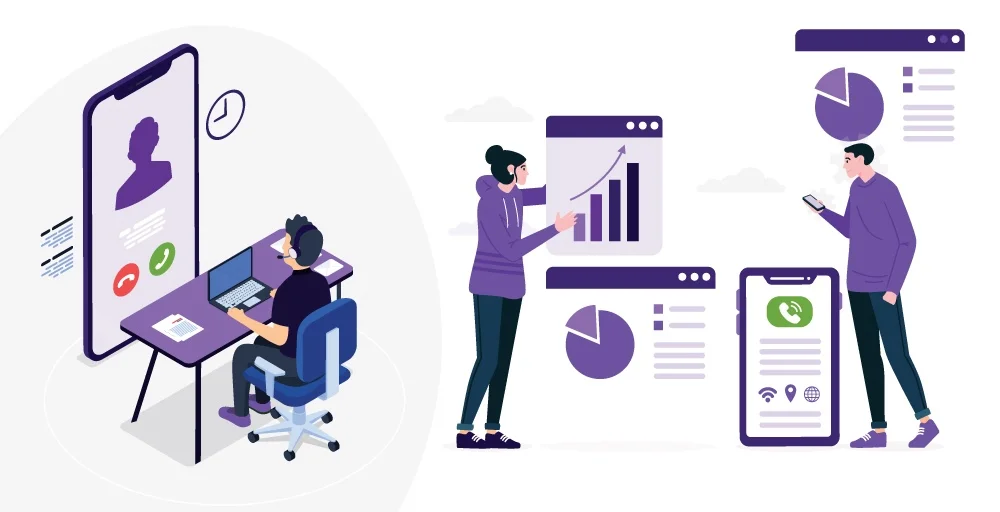
Nowadays, CRM systems allow you to easily and effortlessly collect data from call centers. However, analyzing these data and using them to make better business decisions is challenging. Research has also proven that 72% of companies are unable to build a data-led culture.
Typically, analyzing call center data involves three main phases.
- Collection: Gather all your contact center data into one place, whether it’s a central database, CRM system, or analytics software. This way, you can easily keep track of important metrics like resolution rates.
- Analysis: Turn the raw data into clear reports and visual aids that your team can easily understand. Utilize templates to boost business intelligence and ensure everyone is on the same page.
- Action: Harness insights from data to enhance agent performance effectively. Establish benchmarks for customer satisfaction and other essential performance indicators to foster sustainable growth.
Once you have completed the analysis of the data, you can use this valuable information in various ways. You can track agent performance, average handle time, top call volume, and more to improve customer service. Here’s how you can leverage this data:
1. Track Agent Performance
Call center analytics always keep an eye on the agent’s performance and provide accurate data. Then, supervisors can view the specific reports to check in with one or more agents to find where they are lacking.
In addition, managers can check how long agents take to resolve customer queries using the average handle time by skill report. These valuable data help supervisors and managers identify the specific areas for coaching to improve their agent performance.
2. Improve Customer Relationship
Agents need to personalize their interactions with customers during conversations to build strong relationships. To achieve this, you need a complete view of customer history, including their past interaction, past purchases, and concerns.
Call analytics provide all this data, allowing you to tailor conversations and proactively address potential problems. Besides that, predictive analytics empower proactive care, allowing agents to reach out before issues arise, demonstrating a commitment to preventing problems.
3. Act on Customer Data in Real-time
Call center analytics now empower agents with real-time customer data, transforming average interactions into exceptional experiences. While on the call, agents can view survey responses, unresolved requests, and the customer’s entire journey.
This real-time sentiment analysis allows them to personalize greetings, address concerns proactively, and ensure a smooth resolution.
How Does Call Center Analytics Impact Customer Experience?
Call center analytics plays an important role in shaping customer experience. It provides valuable data-driven insight that can be used to improve various aspects of the call center operation. Here’s how:
- Personalized interactions: Call center analytics provide a comprehensive customer history, including purchase history and past interactions. Agents can easily access this data, which helps them personalize interactions. This personalization fosters a sense of connection and improves customer experience.
- Proactive problem-solving: With the use of predictive analytics, you can identify potential customer issues prior to customer concerns. Then, you can contact customers to offer solutions instantly. This proactive approach shows care and a commitment to preventing problems, leading to a more positive customer experience.
- Improved emotional intelligence: During phone calls, agents can’t know about customer sentiment. However, with sentiment analysis software, you can identify customer sentiment based on voice recordings and text interactions. This focus on emotional intelligence strengthens customer relationships by acknowledging their feelings and demonstrating a genuine desire to help.
- Targeted feedback and continuous improvement: Call center analytics allows you to identify customers who’ve had exceptional or negative experiences. Then, you can target them for surveys, which will enable you to gather specific feedback, address concerns promptly, and recognize excellent service delivered by agents.
Top 3 Call Center Analytics Software
Here are the top three call center analytics software:
1. KrispCall
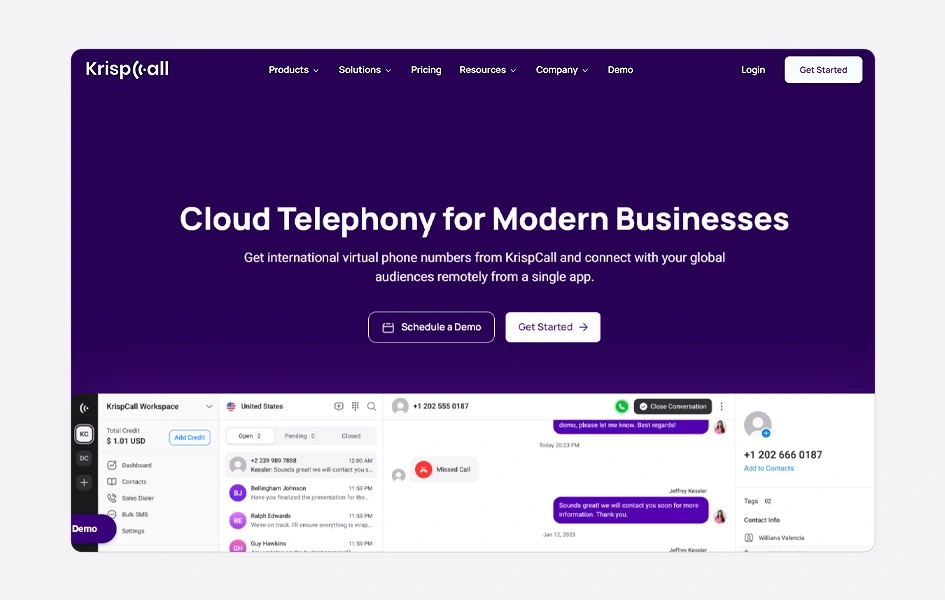
KrispCall is one of the best call center analytics software that helps you improve your call center performance in your journey. It provides you with easy-to-use analytics in contact center operations. It offers a wide range of features, including real-time monitoring of call volume, Interactive Voice Response, unified callbox, and more.
In addition, KrispCall offers wallboard software, providing real-time insights into call center performance in a single dashboard. Managers can also track metrics for individual agents. With a wide range of features and an easy-to-use interface, KrispCall is the one and only better partner for call center analytics software.
Key Features
- Real-time Dashboards
- Individual Agent Metrics
- Call Recording Analysis
- Business tools and CRM integrations
2. Talkdesk IQ
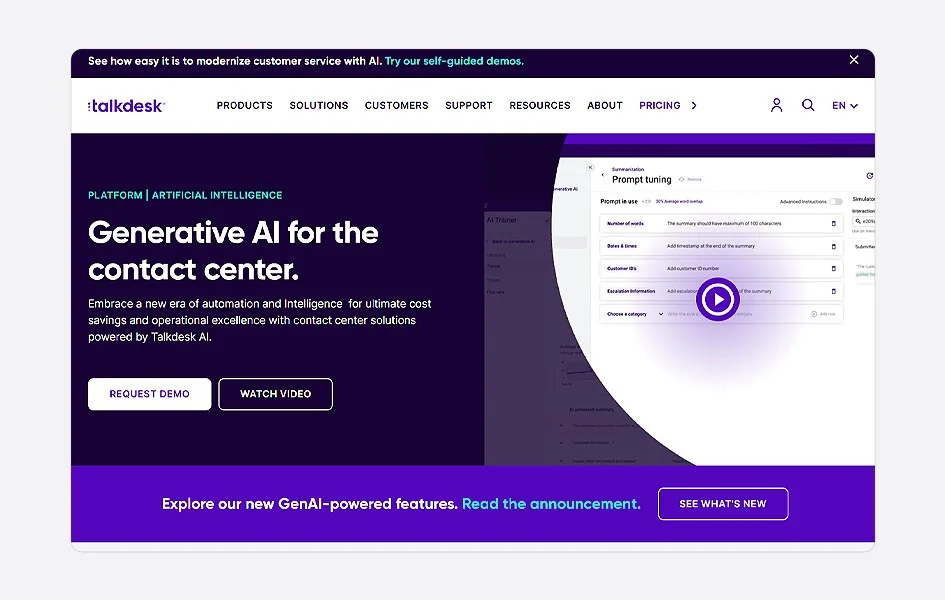
Talkdesk IQ is a leading cloud-based contact center platform that offers a comprehensive call center analytics software solution. It provides a robust set of features for businesses of all sizes. However, the main strength of Talkdesk IQ is its speech analytics capabilities.
With Talkdesk IQ’s advanced speech analytics software, you can transcribe calls and conduct sentiment analysis. This invaluable tool allows you to gauge customer experiences, whether positive or negative, during their interactions with your company. Moreover, Talkdesk IQ offers custom reporting and seamless integration with top CRM platforms.
Key Features
- Real-Time Analytics
- API-Based Analytics Dashboard
- Customer Interaction Monitoring
- AI-Powered Chatbots and IVR Systems
3. InContact Analytics
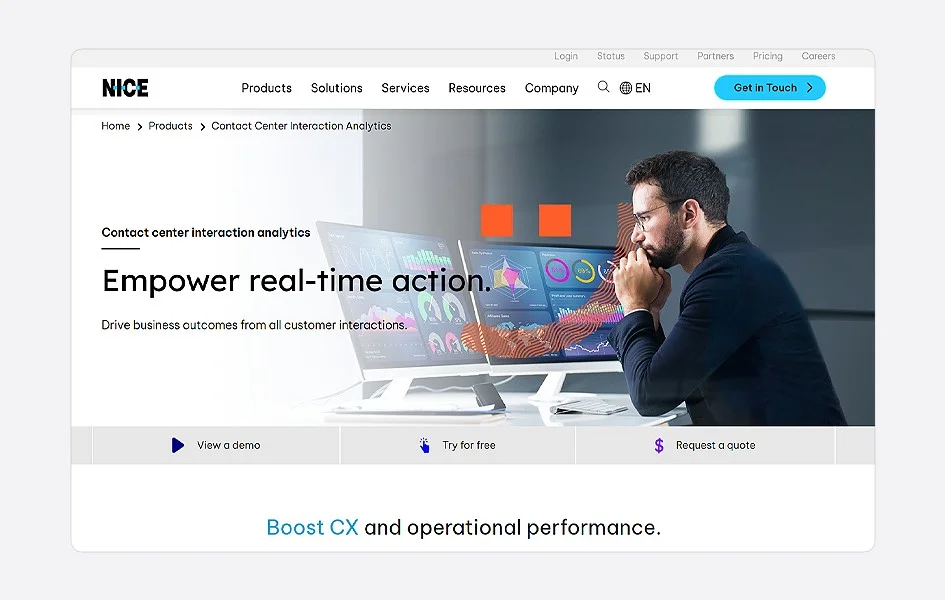
InContact Analytics, from Nice inContact, is a viable call center software provider that offers a comprehensive solution for analyzing customer interactions across various channels. Its software provides actionable insights from every customer interaction.
InContact analytics mainly provides its service to mid to large contact centers. It offers powerful features that help businesses improve customer experience, agent performance, and operational efficiency.
Key Features
- Actionable Insights
- Omnichannel Experience Tracking
- Agent Behavior Analysis
- Quality Management Tools
Use KrispCall as the Call Center Analytics Software to Gain Customer Insights and Boost Customer Experience
Every business is required to offer exceptional customer service to increase customer satisfaction. To do this, you need to gain an insight into customer needs, preferences, and behavior. But how can you do this?
The solution is to use KrispCall call center analytics. Using KrispCall, you can get a 360-degree view of call data. You can access the total call volume including inbound, outbound, and missed calls of each day. In addition, you have visibility into the number of calls initiated and received by each agent.
Besides that, you can download reports of those call data on a weekly, monthly, or yearly basis. This report helps you identify customer preferences and empower informed decision-making to improve customer service.
Conclusion
Call center analytics software is becoming an integral part of contact center operations. This software offers you several features, such as seamless data integrations and instant metrics, that help you improve your overall call center performance.
Call center analytics comprises a range of tools and techniques, each providing distinct insights. This includes interaction analytics, speech analytics, predictive analytics, and more. It helps you boost agent performance, improve customer satisfaction, and track agent progress in real-time. While offering several benefits, it also has some drawbacks, including increased pressure on agents.
However, the benefits of using the right call analytics software can outweigh any disadvantages. And if you are looking for call center analytics software, go for KrispCall. It is one of the top call center analytics software providers.
✅ Book a free KrispCall’s demo now!
FAQ
What are analytical skills in a call center?
Analytical skills in call centers are the ability to investigate a problem and find the ideal solution in a timely, efficient manner. These skills are used when detecting patterns, brainstorming, interpreting data, integrating information, and making decisions based on multiple factors.
Here are some vital analytical skills for call center agents:
- Problem-Solving
- Critical Thinking
- Identifying Trends
- Data Analysis
How can I track my call center productivity?
To track call center productivity, you can use the following metrics:
- Average call duration
- First call resolution rate
- Abandonment rate
- The average speed of answer
- Quality assurance (QA) score
How to improve call center analytics?
To improve call center analytics, consider the following strategies based:
- Determine the key performance indicators (KPIs) that align with your business goals and customer service objectives.
- Take advantage of call center analytics software that leverages AI technology, real-time updates, and behavioral predictions.
- Incorporate predictive analytics to forecast future trends, such as call volume fluctuations, staffing needs, and customer behavior patterns.
- Use voice and speech analytics to monitor audio interactions and analyze conversation tone, pitch, stress, and rhythm.
- Implement customer satisfaction analytics to gain insights into customer preferences, behavior, and satisfaction levels.

